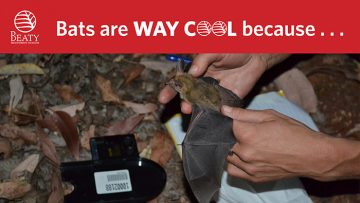 Going to bat for bats – discovering the quirks of Western Australia’s furry flying mammals.
Going to bat for bats – discovering the quirks of Western Australia’s furry flying mammals.
Bat wings and human hands share the same types of bones so it isn’t surprising that the scientific name for bat Chiroptera means “hand-wing.” Despite having eyesight comparable to humans, bats also use echolocation to navigate and find their food. Similar to sonar, echolocation is best described as the ability to ‘see with sound.’ Bats send out high frequency sounds waves through their mouth or nose and use their sensitive ears to detect the echoes that bounce back to learn about the size, texture and distance of surrounding objects. Post-doctoral researcher Joanna Burgar will take you on a trip down under to fly with these exquisite, enigmatic creatures through the eucalypt forests of south-western Australia, and explain how her PhD research is helping a mining company restore forest to benefit bats now and into the future.
Included with museum admission or membership.
